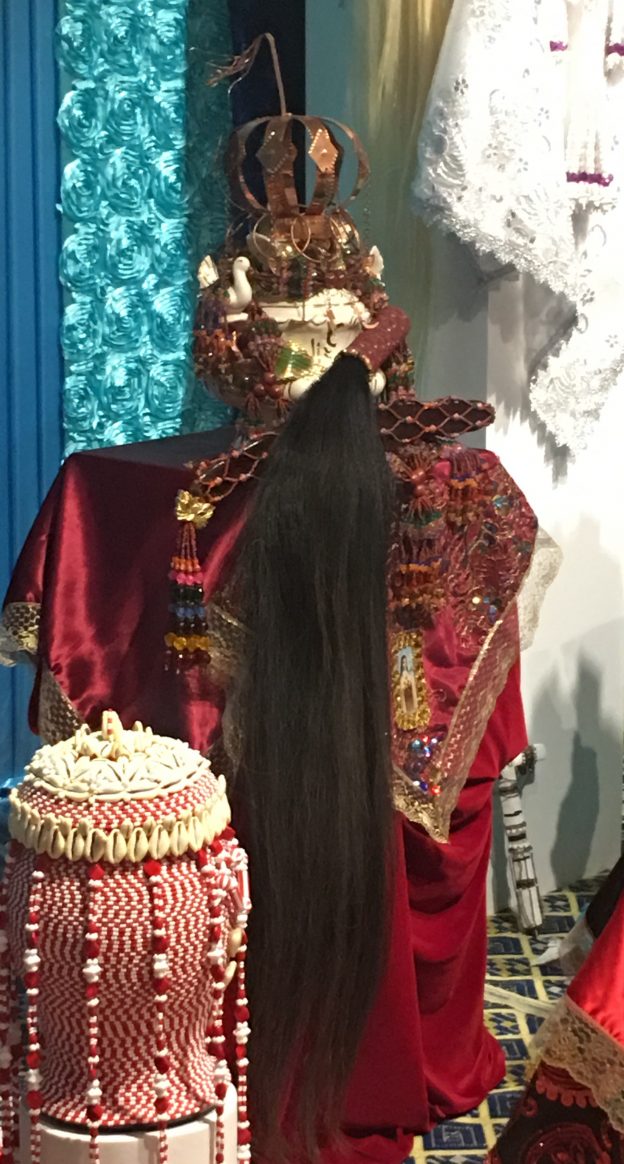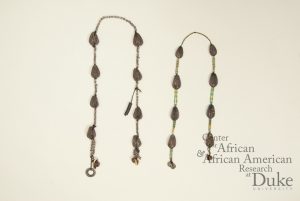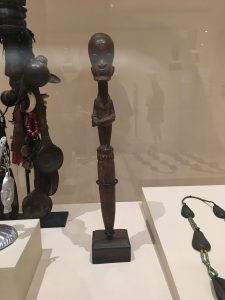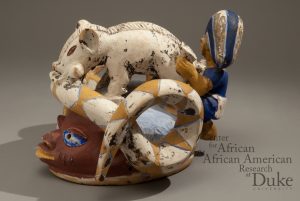
I am researching the Gelede Mask because I want to find out more about the complex nature of gender roles in Yoruba culture and investigate how different symbols in the Gelede mask are linked to gender relations. The Gelede mask depicts a woman’s face with a snake curling around the top of her head, a red-eyed warthog arched across the top of the mask and the figure of a hunter behind it. This mask is a staple in the Gelede Society, a group made up primarily of males, although each chapter is typically led by a female. The members join in effort to sort through problems that arise in their lives and others’–the biggest problem they deal with is impotency, thought to be caused by witches. This mask would typically be worn by a member of the society as they carry out a ritual to convince the witches in their lives to use their powers for good instead of evil. The face on the mask is intended to represent a beautiful woman, which helps influence the witches.
In Professor Abiodun’s article, Àṣẹ: Verbalizing and Visualizing Creative Power through Art , the idea that power can come from visual art (especially sculpture) was discussed in depth, and that reminded me of my studies with the Gelede mask. Abiodun discussed the power visual art, such as intricate masks, has to create change/make things happen. He states that “Yoruba artists have . . . a special kind of understanding of a person, thing, or phenomenon. This is the source of an aesthetic consciousness with witch the artist must perceive the individualized form, color, substance, rhythm, outline, and harmony of a subject” (311). This special understanding is what gives the symbols on the Gelede mask the power to influence witches and create good change. Visual art is a powerful phenomenon in Yoruba culture–the symbols created on the Gelede mask are linked to gender relation both within the Gelede Society and in the general atmosphere of Yoruba culture.
To complete my research on the Gelede mask, I’ll need many primary sources such as interviews, films, and books written by people who have firsthand experience with the Gelede society. Secondary sources are also going to be very helpful, such as articles written by professors and other scholars that analyze the firsthand experiences and produce helpful insights about the symbols in the mask and how they are linked to the gender relations in the society. A combination of both of these types of sources should help me complete my research and answer my research question.



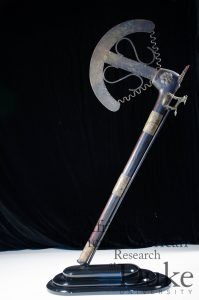 I am studying Fon scepter for the God Hevioso. This object is a wooden staff with an axe like head and is used in political and festival practices in what is now modern day Benin. I want to study this object because I want to learn more about the use of these scepters in court and religious practices. I also want to know more about this specific scepter and the king or Oba who carried this scepter and the effect it had on the Fon people. I want to know more about how the designs on the scepter represent the king who held it and Hevioso the God of Thunder. This research will help the reader understand that objects that are taken out of festivals have little to no meaning unless it is shown in a practical sense. It helps the reader understand that each object has a much deeper meaning and each king has a god representing them.
I am studying Fon scepter for the God Hevioso. This object is a wooden staff with an axe like head and is used in political and festival practices in what is now modern day Benin. I want to study this object because I want to learn more about the use of these scepters in court and religious practices. I also want to know more about this specific scepter and the king or Oba who carried this scepter and the effect it had on the Fon people. I want to know more about how the designs on the scepter represent the king who held it and Hevioso the God of Thunder. This research will help the reader understand that objects that are taken out of festivals have little to no meaning unless it is shown in a practical sense. It helps the reader understand that each object has a much deeper meaning and each king has a god representing them.

